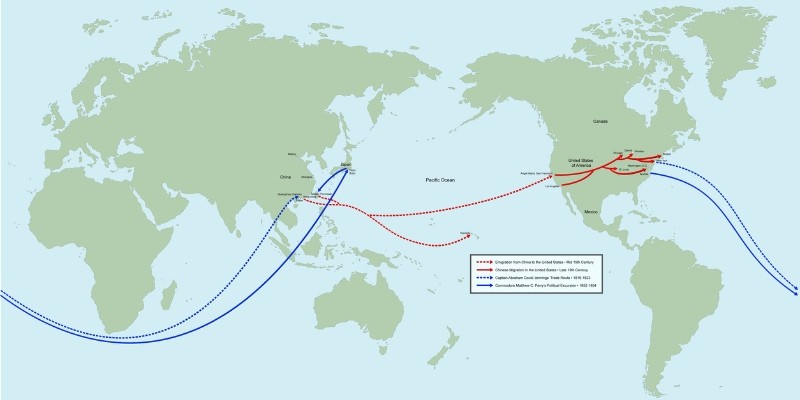History of Chinatown and laundromat of Chinese Immigrants in Michigan
Introduction
Text-to-speech Audio
The Chinese Community experienced different obstacles while immigrating to Michigan in the 1870s. Some historical actors were impacted by Americans' discriminatory thoughts toward the Chinese. In Michigan, Grand Rapids was the main area that Chinese Immigrants lived and worked in laundromats. Chinatown faced challenges while exporting to Michigan, but it has shown how the Chinese community built a culture in Michigan.
Images
Chinese Immigrant trading routes

Chan Hoy laundry business

Backstory and Context
Text-to-speech Audio
In the 19th Century, Chinese people started to discover trade routes. They began trading goods with other countries and strived to find work at various places. In different states, Chinese workers would labor on sugar plantations, gold mines, and textile mills. As shown in the map below, China was trading with New England with imported items like Teas, Silk Porcelain, and Wallpaper.[1] In the mid-1800s, they found work to increase the economy by building roads and buildings, which led them to railroads. This built a community for Chinese people because they worked in various places and assisted America in production. This also led to the creation of Chinatowns, where cultural holidays and traditions were celebrated.
Later, the United States created the Chinese Exclusion Act of 1882, which stopped Chinese immigrants from entering the U.S (United States), which had a negative effect on Chinese people because most men from China were being sent to America for a better life and to aid their family from being in a poor or harsh society.[2] Also, many businesses closed and families were separated. This gave Chinese people a definition that their life was suffering in America, and they had to figure out a way to provide for their families.
Michigan had a ton of developing industries and growing lower and middle-class families. Once settled, Chinese people constructed independent businesses, which aided families who were looking for work. That is when the rise of laundry business became popular in Grand Rapids. Chinese people thought it was especially important to wash, iron, and mend clothes. Chinese men that were working in laundromats were making eight pounds, which is enough to provide for their families at that time. The image below shows, A Chinese woman named Chan Hoy, who started her first laundromat business because that is the only type of work she was allowed to do. [3]
Since Chinese immigrants moved into Grand Rapids, they worked in laundromats as their first job. At the time, it was ridiculously hard for Chinese Immigrants to obtain citizenship because they were not a resident. For example, a man named Wong Chin Foo immigrated to America in 1874 and was not a resident, but obtained his citizenship papers and was granted one after he worked in a laundry business to provide for his family. In 1875, three men that were the first residents in Grand Rapids, two of them named Wau Lee and Ah Tun owned an O.K. Laundry business. After in 1880, a man named Young Joe took over the business and had a proprietor named Lam Fook who died in his partner's basement. This story came to show how the business needed more people to work for them. This is a huge part that affected the Chinese community in Grand Rapids. [4]
A community that I would want to know about Chinatown is the Association of Chinese Americans because they suggest Chinatown as a place where growth started for Chinese people, and it creates a symbol of how Chinese people struggled to immigrate to America. [5] Also, this organization supports Chinese people with education, health for elders, and different organizations and clubs. This is why I believe the Association of Chinese Americans should create a Clio Point for Chinatown. [5]
OK Laundry and other laundromats show how Chinese people fought through the obstacles they faced when they immigrated to Michigan and how they supported their families. It also gave a symbolization of how the culture grew because of how they went from trading with different countries, to owning laundromat businesses that became huge for the Chinese community, as well as all the celebrations that happened. A connection that could be made is that currently China has a lockdown in Shanghai, so some middle-class families decide to move to America to live with fewer restrictions. Chinese people have given a message to the history of where they grew up, when they got involved in America‘s environment, and how their culture is spreading around the world.
Sources
[1] Detroit Chinatown, “History | Detroit Chinatown,” Detroit Chinatown, October 28, 2022, https://detroitchinatown.org/history/.
[2] Detroit Chinatown, “History | Detroit Chinatown,” Detroit Chinatown, October 28, 2022, https://detroitchinatown.org/history/.
[3] Detroit Chinatown, “History | Detroit Chinatown,” Detroit Chinatown, October 28, 2022, https://detroitchinatown.org/history/.
[4] Grand Rapids Community Media Center- www.grcmc.org, “The Earliest Chinese in Grand Rapids,” History Grand Rapids, September 30, 2007, http://www.historygrandrapids.org/photoessay/1664/the-earliest-chinese-in-grand-..
[5] “Association of Chinese Americans – Serving the Local AAPI Community in the Metro Detroit Area since 1972,” Association of Chinese Immigrants, July 30, 2023, https://acadetroit.org/.
Detroit Chinatown, “History | Detroit Chinatown,” Detroit Chinatown, October 28, 2022, https://detroitchinatown.org/history/.
Grand Rapids Community Media Center- www.grcmc.org, “The Earliest Chinese in Grand Rapids,” History Grand Rapids, September 30, 2007, http://www.historygrandrapids.org/photoessay/1664/the-earliest-chinese-in-grand-..
